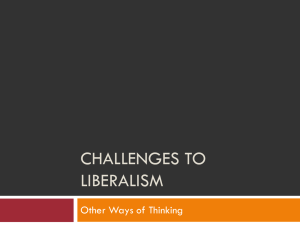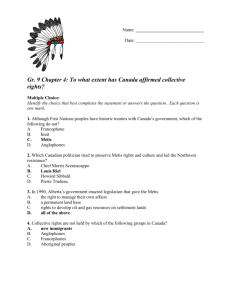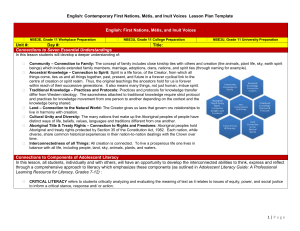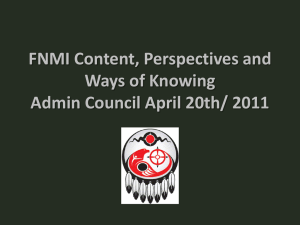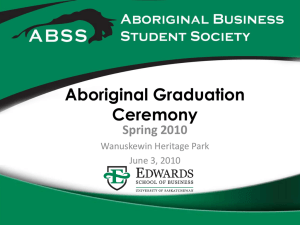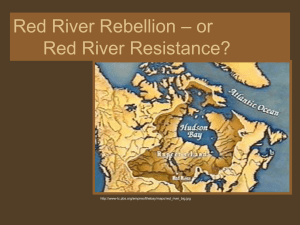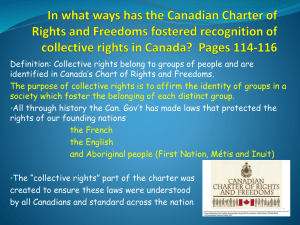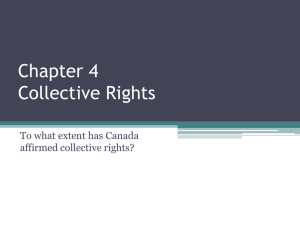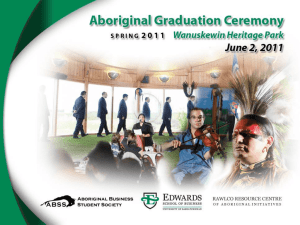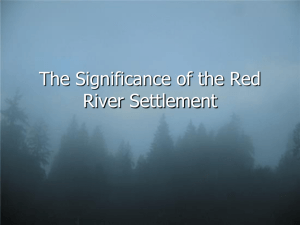How has collective rights impacted the legislative process in Canada?
advertisement
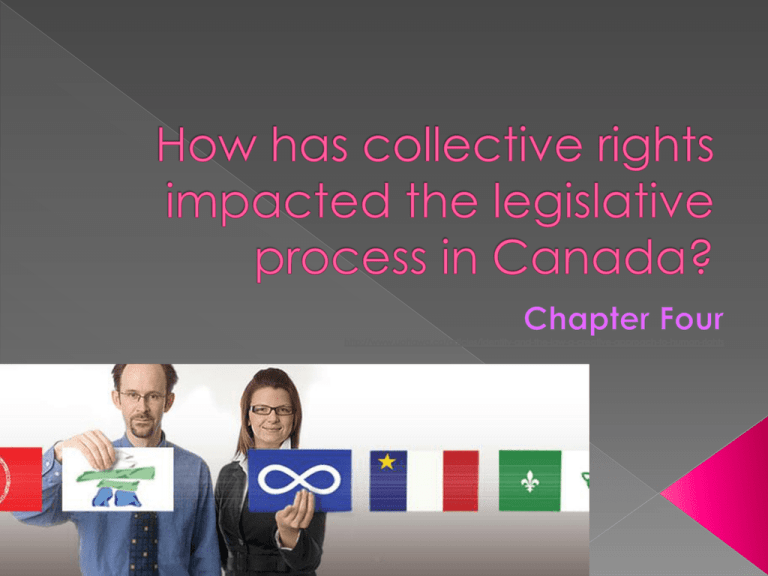
The ways the CCRF has fostered recognition of collective rights The ways the CCRF meets the needs of Francophones in a minority setting The ways the CCRF meets the needs of Francophones in Québec How much the federal and provincial governments support and promote the rights of official language minorities in Canada How the Indian Act recognizes the status and identity of Aboriginal peoples How legislation like Treaty 6, 7, 8 recognizes the status and identity of Aboriginal peoples How the governments recognize Métis cultures and rights through legislation http://www.cooperativeindividualism.org/political-economy-of-calvin-andhobbes-5.html Collective Rights – rights guaranteed to a specific group in Canadian society for historical and constitutional reasons. › Aboriginal peoples (First Nations, Inuit, and Métis) › Francophones and Anglophones Collective Identity – the shared identity of a group of people, especially because of common language/culture Ethnocentrism – the belief that your own cultural group is superior to others Every citizen has rights in Canada, not everyone has collective rights You only get collective rights if you belong to one of the groups (Aboriginal, Francophone, Anglophone) People’s collective rights are protected under the constitution just like CCRF Aboriginal Peoples › First Nations › Inuit › Métis Anglophones Francophones Represents the founding people of Canada http://beatdiaspora.blogspot.com/2008_10_01_archive.html http://www.canadiandesignresource.ca/officialgallery/symbols/metis-nation-flags/ Do you know what these symbols are? A look at the legislation which established Aboriginal collective rights. http://www.fanpop.com/spots/inuit/images/18046133/title/symbol-photo There are 11 Treaties in total Treaty talks began after the Royal Proclamation of 1763 Treaties affect the rights/identities of the First Nations people First Nations would get things like education, reserves, annuities, hunting/fishing rights and farming assistance in exchange for land/resources The Numbered Treaties are sacred. They cannot be changed without the First Nations consent http://apihtawikosisan.wordpress.com/2011/07/05/the-more-things-change-the-more-they-stay-the-same/ Avoid war › In the USA there was a fight for land, Canada could do the same › Many First Nation casualties › Canada wanted to link BC, they would take drastic measures First Nations wanted to secure their future › › › › › Smallpox and tuberculosis Buffalo gone Fur trade done European settlements Things weren’t going well… Working in partners, look from page 129-135 and compare the First Nation’s perspective with the Canadian Government’s perspective on the treaties. http://embracingbevin.blogspot.com/2010/10/we-are-twice-armed-if-we-fight-with.html First Nations feel that land is not something people can own/give up and that land is part of their culture › This is why there can be issues First Nations recorded Treaties in their oral histories (not written down) Government recorded Treaties in English The oral/written records disagree on aspects: Why do you think this would be? Made rules about First Nation’s lives without consulting them Refers to the rights/status of First Nations peoples Parliament thought the First Nations needed guidance › Ethnocentric View – felt that Canadian (European) culture was better than First Nation’s culture http://ma-nouvelle-vie-en-france.blogspot.com/2011/02/french-are-ethnocentric.html Confirmed collective rights of the First Nations › This Act made policies for the laws (Treaties) that were created Indian Agents were created › They would then interpret the Treaty rights The Act has who is considered “status Indians” › These are the First Nations who receive Treaty rights › Status Indians do not have to pay taxes, but most First Nations do if they are not part of a reserve Originally tried to assimilate the First Nations › Told them how to run their government › Restricted traveling, political, cultural aspects › Had to give up Treaty rights if they wanted to vote › Residential schools The Act clearly has been revised many times. It is still in place today. Have taken out the majority of the racist, ethnocentric elements It needs to be updated now but there are issues with this › First Nations feel they are not adequately consulted for the revisions › Until this happens, the Indian Act will not be updated What does this say about our constitution? No… this would NEVER be a question on your exam… http://www.mediaindigena.com/rickharp/issues-and-politics/poll-should-the-indian-act-be-gone-by-2015 Here are more First Nations legislation which has occurred in Canada http://www.canadaflagmart.com/servlet/the-10/First-Nations-Canada-Flag/Detail What does this show you about residential schools? http://www.abbacanada.org/pastletter.html Meant to “educate” First Nations and assimilate them at the same time Removed children from their families Took away their language, culture and identities The government is now compensating former students from the trauma they suffered http://www.youtube.com/watch?v=s_V4d7sXoqU http://www.danielnpaul.com/IndianResidentialSchools.html Made to: › Maintain Treaty rights › Increase social/economic welfare to its peoples › Obtain better education/opportunities › Cooperate with federal, provincial, local governments for their benefit The government wanted to get rid of the Treaties › Said that it was discriminatory legislation First Nations did not support this › Lots of protest › Treaties are considered legal obligations › Can’t just get rid of them http://bcinto.blogspot.com/2009_01_01_archive.html First Nations wanted their rights entrenched (fixed firmly) in the constitution Their rights were put into the constitution in 1980 before it was patriated › Section 35, Canada’s constitution recognizes First Nations, Métis and Inuit peoples as Aboriginal peoples, and recognizes their existing Treaty and Aboriginal rights The constitution was patriated in 1982 › To bring to a country something that belongs to the country First Nations look to be recognized as a diverse peoples Still have modern treaties (establish new land claims mostly) Make sure that the Treaties are being followed Both the government and First Nations agree that things need to be changed/updated, but they must work together to get that accomplished A look at the legislation which gives the Métis collective rights! Don’t have any historic treaties with Canada’s government Considered part of the Aboriginal peoples of Canada Have inherent rights because they are First Peoples Led to the establishment of the Manitoba Act › Established Manitoba as a bilingual province › Catholics and Protestants were given education rights › Métis were given land rights (scrip) Gave the Métis land rights along the Red River Showed that the government needed to negotiate with them to get things done The government had to take them seriously A document that could be exchanged for land for land Had to choose between scrip or becoming a Treaty Indian Government felt that they did not have the same rights as First Nations http://www.collectionscanada.gc.ca/treaty8/020006-3050-e.html Métis wanted to protect land rights in Saskatchewan Riel and the Métis led a resistance against the government Lots of fighting, Riel ended up being hung Again showed that the government needed to take the Métis seriously http://culturepopped.blogspot.com/2009_04_01_archive.html Established in 1938 Lobbied the government for land › Was the first time Métis had land set aside for them Enabled the government to pass the Métis Betterment Act › Made for 12 temporary Métis settlements › Métis did not have control of the land › If land was found to be unsuitable for farming/fishing, it could be given back to the government The Métis lobbied to get recognition in the constitution Just like the First Nations and Inuit, they were put into Section 35 as one of Canada’s Aboriginal peoples with rights Alberta Government gave the Métis a permanent land base and could handle their own business Could develop oil/gas on settled lands Gave them autonomy (authority to make decisions) Supreme Court approved the Métis right to hunt and fish since they are under the constitution as one of Canada’s Aboriginal peoples › Métis have the same relationship to the land as First Nations people In 2007, they took these rights away and made it so that Métis had to get licenses to hunt/fish. Some people agree that Métis deserve these rights while others think that everyone deserves those rights. › They did not consult the Métis before making this decision Got this off of a test somewhere…. Section 16-20 of the Charter English and French are the official languages Makes New Brunswick the only official bilingual province Manitoba was a bilingual province With this act, public funding was cut for Catholic Schools › The Catholics spoke French › The Protestants spoke English Act made Manitoba and English speaking province only A group of people who speak one of Canada’s official languages (English, French) but do not live in an area where the majority of the population speaks their language Section 23 – Schools need to exist so that one can practice their language if they are in a minority language setting › Francophone/Anglophone schools › Must be publicly funded Law established in Québec in 1977 Made French people a distinct people who should be able to express their identity French became the language of government, work, education and business Signs in Québec must be in French › Can have English on, but the French should be more prominent Francophone parents cannot educate their kids in an Anglophone school › Immigrant parents can if their child has had some education in English, otherwise they must go to a French school Maintenant un examen!
